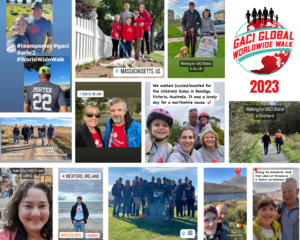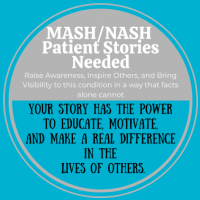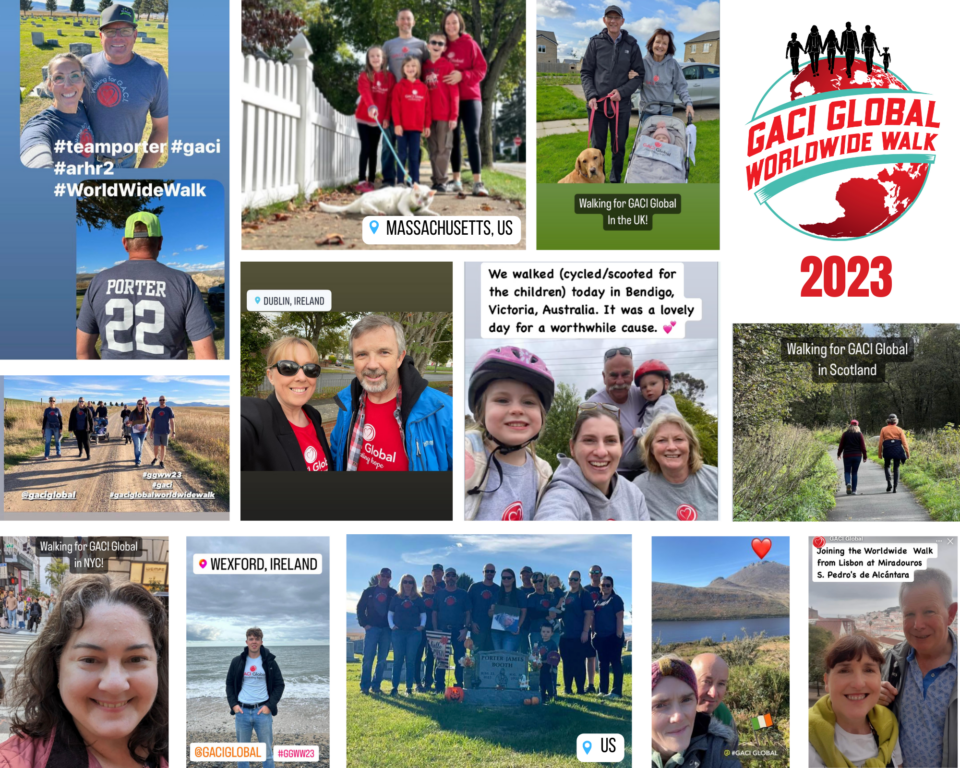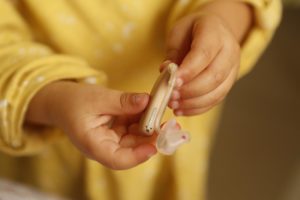
Rare Community Profiles is a Patient Worthy article series of long-form interviews featuring various stakeholders in the rare disease community, such as patients, their families, advocates, scientists, and more.
Creating a Strong Patient Advocacy-Pharma Partnership: How Inozyme Pharma and GACI Global Came Together for Impact
Rare disease awareness is critical—not just in understanding more about the diseases themselves, but in supporting families and advancing research.
But when Liz Molloy and Christine O’Brien learned that their children had a rare genetic disease called Generalized Arterial Calcification of Infancy (GACI), they were shocked to learn that awareness was slim at best. In fact, there was hardly any available information on GACI, its effects, or its impact on their children. Christine shares:
“We saw this as an opportunity to fill that unmet need, so Liz and I started a private support group in 2014.”
Four years later, at the Global Genes Summit, four of the families from the support group—Liz’s and Christine’s families included—officially banded together to create a nonprofit organization.
GACI Global was born.
Since its founding, GACI Global has made it a mission to circulate hope while connecting families affected by GACI and/or ARHR2 (Autosomal Recessive Hypophosphatemic Rickets Type 2) caused by ENPP1 Deficiency and ABCC6 Deficiency. The organization has made strides in increasing education around GACI and ARHR2, spurring research, and cultivating a broader understanding of these disorders both within and beyond the medical community. This has included partnering with Inozyme Pharma, a clinical-stage rare disease biopharmaceutical company developing a potential first-ever approved treatment for GACI/ARHR2 and other rare diseases of abnormal mineralization.
Recently, Liz and Christine, alongside Catherine Nester, BSN, Inozyme Senior Vice President of HCP and Patient Engagement, spoke with Patient Worthy more about their partnership, its initiatives, and how to develop a strong patient advocacy-pharma collaboration that fulfills the missions of both organizations.
About Generalized Arterial Calcification of Infancy (GACI)
Before we begin, let’s first make sure that we have an understanding of what Generalized Arterial Calcification of Infancy is. GACI is also known as idiopathic infantile arterial calcification, idiopathic arterial calcification of infancy, occlusive infantile arterial calcification, and occlusive infantile arteriopathy. This rare genetic condition was first described in 1899 and there have been roughly 200 cases reported in medical literature since then. As Liz explains:
“GACI affects the circulatory system. Infants with GACI are born with ABCC6 or ENPP1 mutations that cause the body to have low levels of pyrophosphate, which causes issues with regulating calcification. It is life-threatening and can cause blood clots, stroke, and heart failure. Sadly, 50% of babies born with GACI don’t survive. Those who do face chronic, life-long complications. It is a devastating diagnosis for any families that receive it.”
Infants born with GACI may show symptoms such as failure to thrive, cardiomyopathy, dental abnormalities, narrowed arteries, hearing loss, difficulty breathing, high blood pressure, irritability, feeding difficulties, and reduced or absent pulses. There are no approved treatments for GACI.
The Importance of Awareness
When GACI Global was founded, Christine and Liz made a commitment to supporting the community in whatever ways they could. At Global Genes events in 2018 and 2019, Liz and Christine connected with Catherine and other members of the Inozyme team, who were inspired by GACI Global’s mission. As the two groups began to talk, they realized that they shared a goal: to improve the treatment landscape for, and lives of, those affected by GACI and ARHR2.
Soon, GACI Global and Inozyme decided to partner. Christine explains:
“This partnership is driven by a shared commitment to improving the lives of patients and families faced with GACI. Inozyme’s dedication to developing potentially life-saving treatments lines up with our mission. We appreciate that Inozyme recognizes the importance of this goal.”
One crucial way that the partnership has advanced the mission of GACI Global is by providing additional avenues for awareness. As Christine shares:
“Raising awareness for GACI, and rare diseases in general, is very challenging due to limited resources and a lack of information. Many families in our community are in the thick of multiple doctor appointments and taking care of their child, so it’s hard to focus on raising awareness. When you have such a small community to start, that makes it even more difficult. Partnering with Inozyme has enabled us to reach a broader audience. Inozyme attends medical conferences around the world and has fought to have these deficiencies included in newborn screening programs. It’s amazing what we have already accomplished.”
These medical conferences also provide a platform through which Inozyme can raise awareness of what GACI looks like—and at least get healthcare providers to think rare. Some infants with GACI go undiagnosed because doctors don’t always know what to look for. Says Catherine:
“Doctors think that they won’t see a rare disease, so they aren’t necessarily looking at what is in front of them. When we go to meetings, we want physicians to understand what the symptoms are so they can recognize them. Everyone deserves the right diagnosis. Whether there’s a treatment or not, families deserve to know what they are experiencing.”
An Evolving Partnership
Outside of awareness initiatives, GACI Global and Inozyme have leveraged their partnership to advance research and continue the push toward an eventual treatment or cure. Collaboration has been a centerpiece of their success. Liz explains that:
“The partnership allows us to provide the patient perspective directly to Inozyme so that their initiatives align with the needs of our community. Providing these valuable insights to Inozyme helps them to understand what it is like to live with GACI, have a child with GACI, or lose a child. They integrate this information into their research and have more accurate, up-to-date information for clinical trials. And in response, Inozyme allows us to use their resources to better reach patients and doctors who can connect families to GACI Global.
Connection is huge for us. We want to ensure that families have access to the support and knowledge they need to connect them with other families, experts, or even the investigators at their closest study site. Our partnership has created an avenue for those affected to reach out, but also for doctors to ask about genetic testing and clinical trials. For this, we are incredibly grateful.”
On Inozyme’s end, Catherine explains that this sense of collaboration and trust has given the team a much stronger and more comprehensive foundation to work off of. She notes that GACI Global has taught Inozyme about the disease, its progression, and the needs of various age groups, noting:
“We value this partnership because it helps us develop better research and trial protocols. Early-stage drug development is not for the faint of heart. For the people who are developing and waiting for the treatment, it can be a long, grueling road with many setbacks and challenges. We could not do this without the GACI Global community. Hearing from families or patients and getting to know them—that’s the energy that our team needs to keep us going.”
GACI Global and Inozyme have come together for some great achievements: updating the community on clinical trial information and patient stories, publishing a paper on the burden of disease, and the GACI Global Worldwide Walk—Catherine’s team returned this year for the fourth year in a row and raised $30,250 to increase awareness and research efforts to improve the lives of families affected by GACI and ARHR2.

Partnership Development & Advice
Having a partnership like that of GACI Global and Inozyme can bridge the gaps between research and development; from fundraising and raising awareness to creating better clinical trial protocols, these partnerships begin the path toward treatment development and better outcomes.
But something that I have heard many times—from patient advocacy groups and pharmaceutical companies alike—is that they would like to develop a more robust and mutually beneficial partnership, but they aren’t sure where to begin.
From the patient advocacy side, Christine says:
“Start by identifying the pharmaceutical companies that share your mission and values. Establish clear communication channels. Build a relationship with them and make sure patient voices are not just heard, but respected.”
Liz adds:
“If you’re fortunate enough to work with a company like Inozyme and with a person like Catherine, the earlier that you can do that, the better. It is never too early to start building that relationship.”
On the pharmaceutical side, Catherine notes, it is essential to actually collaborate and work closely with the community—not just to say that a company will do so. She says:
“Drug developers need to listen to the community. They have a lot to say, and it’s important information. Don’t just give them lip service. If you want to form a partnership, give them a seat at your table. Let them look at your protocols and take their feedback seriously. We let Liz and Christine look at every clinical trial protocol we’ve developed and changed those protocols based on their feedback. Regulators and ethics boards are recognizing more and more the role that patient communities have in drug development. We need to do better to integrate their voices. If you’re going to talk the talk, walk the walk. Take it seriously, let them have input, and look for ways to change the understanding of the disease together.
To advance research, to create these partnerships, to develop a drug in a particular disease state—you need to consciously make an effort to connect with that group, to ask questions, to listen when they speak, and to see what shared objectives you have and how to achieve them. This isn’t rocket science. Do the things that you know are right. If you do the best thing for patients, everything else generally works itself out.”
Ultimately, the GACI Global and Inozyme partnership is founded on mutual respect, knowing each party has a voice and a stake in the issue. Together, these groups are patiently waiting for and working towards a treatment—and we hope that Inozyme’s treatment, a beacon of hope for the GACI Global community, becomes a success.








